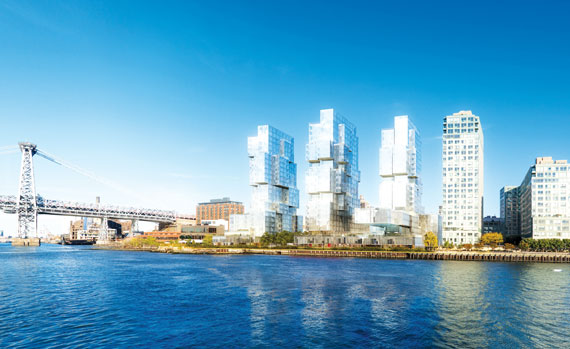Trending
Spitzer’s first development foray ‘socks’ the waterfront
The ex-governor returns to his real estate roots with three bulky towers just south of the Williamsburg Bridge

Three hulking, deconstructed and robotic monsters — I mean that in a good way — will soon rise over the Williamsburg waterfront. And if the renderings are to be believed, they look as though they might be able to lay waste to Lower Manhattan.
The renderings are of developments, each of them 24 stories tall, at 416-420 Kent Avenue that will represent former Gov. Eliot Spitzer’s maiden journey on the road to New York City real estate developer. The architect of the project, Eran Chen, of ODA Architects, describes the design (more gently than I have) as a “molded iceberg, sculpted to create the maximum number of views and outdoor spaces.” Spitzerville will include a park and an esplanade along the river.
Like the polder system of the Netherlands, which constantly reclaims land from the sea, the grand strategy of New York City’s recent evolution has been determined, over the past decade and more, by the redemption of former industrial zones, long abandoned or underused, in the name of residential development.
And now it is time for the area of Brooklyn that sits on either side of the Williamsburg Bridge to undergo the transformation that has already been visited upon the Meatpacking District in Manhattan and Long Island City in Queens.

Eliot Spitzer
The best-known project associated with this area is, of course, the Domino Sugar plant, which sits on the northern side of the Williamsburg Bridge, and is being converted into an astounding 4,000 new apartment units.
And now that this other large project at 416-420 Kent is getting underway just south of the bridge as well, it will be only a short time before this entire area is transformed, after the fashion of the High Line, into a privileged zone that caters to the city’s affluent classes (although 20 percent of Spitzer’s project will include “affordable” units).
Spitzer, of course, is the scion of a real estate family: his father Bernard, who died in November at age 90, and was the head of Spitzer Engineering (now Spitzer Enterprises), was responsible for no fewer than 15 residential projects around the city. But the last of those was undertaken over 18 years ago, and his son Eliot is now moving into the development game with a daunting project that might tax the skills of many a more seasoned developer.
This complex is intended as a $700 million residential development whose three towers will comprise 856 rental apartments, as well as two rooftop swimming pools.
Having left politics behind him, Spitzer sails into this project propelled by the recent and triumphant sale of the Crown Building — which his father purchased in 1991 — for $1.78 billion, most of it pure profit.
He selected ODA Architects to design the project, a decidedly young firm founded in 2007 by Eran Chen, who was previously a principal at the prolific local team of Perkins/Eastman. In a short period, he and his firm have produced an impressive roster of striking and original buildings that are clearly of a piece with the latest venture designed for Spitzer Enterprises. These include the plans for the as-yet-unbuilt 10 Montieth Street in Bushwick, as well as the very-much-completed 15 Union Square West from 2011, which was designed when Chen was still working for Perkins/Eastman. (Praise can also be given for the completed 100 Norfolk Street, as well as the project for the as-yet-unbuilt 1800 Park Avenue on 125th Street in Harlem.) In these projects, it is easy to see a formal and stylistic continuum that leads right up to Spitzer’s development on Kent Avenue.

Eran Chen
The dominant stylistic thrust of those earlier projects, as well as of Kent Avenue, has been a kind of hybrid between Neomodernism and Deconstructivism. The vocabulary is overwhelmingly that of glass and steel, right-angled modules that often collect themselves into curtain-walls. But the overall shape of the projects is highly irregular and asymmetrical, assuming bold volumetric forms that, despite the modular units that compose them, achieve a real and memorable drama.
The robotic monsters of Kent Avenue do not remind one of the sleek post-industrial robots of recent years, but rather of the “Rock’em Sock’em Robots” of times past, bulky masses of pure force. The three towers stand near one another, but one is slightly separated from and independent of the other two, which are set side by side. All three are similarly conceived, almost as though each consisted of two slabs pressed together, with each of the pieces mimicking the other in its sundry irregularities. And yet, such is the syncopated massing and rhythm of each of the towers that all three are slightly different in form, even as they are identical in effect.
ODA’s Deconstructivist credentials are proved by the way each of the towers reads almost as though it were a traditional modernist slab that has been warped and bent, all out of shape, as though, within the context of their mid-century machine aesthetic, they underwent an almost organic change that left them in the wayward shape we see in the rendering.
The result is a satisfyingly powerful complex of buildings whose energetic masses will be able to hold their own against the Williamsburg Bridge and the Domino Sugar plant.
There is also a temptation, which I have no intention of resisting, to discern a link between the form of the buildings and the personality of their developer. As the former governor famously yelled at former Republican minority leader James Tedisco, “I’m a f**king steamroller, and I’ll roll over you.” As has been stated, these latest towers are similar in style to other works to emerge from the studios of ODA Architects. But it is my suspicion that Eliot Spitzer chose this firm in the first place because something about the pugnacious style that it already displayed in its sundry earlier projects seemed to coincide with some deep-seated bent of his character. And it also seems plausible that, through the act and art of the developer, which he has just decided to make his own, he now leaves a more dominant mark upon the landscape of Brooklyn and New York City than he ever had time to do when he was governor of the state.




